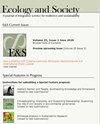评估博茨瓦纳旗舰社区自然资源管理区对适应能力的长期保护影响
IF 3.2
2区 社会学
Q1 ECOLOGY
引用次数: 0
摘要
在过去的30年里,基于社区的自然资源管理(CBNRM)试图在地方层面解决经济发展和生态保护的同步需求,但在发展和保护利益与成功之间往往存在很大的分歧。特别是,CBNRM并不总是产生预期的社会经济结果,而其对家庭层面人类福祉影响的信息很少。在博茨瓦纳,大多数社区不会将CBNRM项目的收益发放给家庭。这导致了固有的规模不匹配,因为与野生动物一起生活的成本是在家庭层面上感受到的,而利益是在社区或村庄层面上支付的。我们使用相隔22年的两次家庭调查的纵向数据来评估博茨瓦纳CBNRM模式的收益是否提高了与野生动物一起生活的家庭的适应能力。我们采用生计资本方法制定适应能力指标,并衡量1995年至2017年间博茨瓦纳北部五个社区的生计多样性、不平等和适应能力的变化情况。我们的分析证实了定性评价的结果,并表明CBNRM在改善家庭层面适应能力方面的贡献表现不佳。如果大多数社区成员没有体验到幸福感的增加,CBNRM就不能说对社区有益。因此,我们建议重组CBNRM和其他社区保护方法的治理模式,以确保利益更直接地针对积极参与的家庭。本文章由计算机程序翻译,如有差异,请以英文原文为准。
Assessing long-term conservation impacts on adaptive capacity in a flagship community-based natural resources management area in Botswana
Over the past three decades community-based natural resources management (CBNRM) has sought to address the concurrent needs of economic development and ecological protection at the local level, but there is often strong divergence between development and conservation interests and successes. In particular, CBNRM has not always led to expected socioeconomic outcomes, while information of its impact on human well-being at household level is sparse. In Botswana, most communities do not disburse benefits from CBNRM ventures to households. This leads to an inherent scale mismatch that arises because the costs of living with wildlife are felt at the household level, while the benefits are paid out at the community or village level. We use longitudinal data from two household surveys conducted 22 years apart to assess if benefits from the Botswana model of CBNRM have increased household-level adaptive capacity for those living with wildlife. We take a livelihoods capital approach to develop indicators of adaptive capacity and measure how livelihood diversity, inequality, and adaptive capacity have changed in five communities in northern Botswana between 1995 and 2017. Our analyses confirm the findings of qualitative reviews and suggest that CBNRM is under-performing in its contribution to improved household-level adaptive capacity. CBNRM cannot be said to benefit communities if the majority of community members do not experience increased well-being. We therefore recommend restructuring the governance models of CBNRM and other community conservation approaches to ensure that benefits are more directly targeted to actively participating households.
求助全文
通过发布文献求助,成功后即可免费获取论文全文。
去求助
来源期刊

Ecology and Society
环境科学-生态学
CiteScore
6.20
自引率
4.90%
发文量
109
审稿时长
3 months
期刊介绍:
Ecology and Society is an electronic, peer-reviewed, multi-disciplinary journal devoted to the rapid dissemination of current research. Manuscript submission, peer review, and publication are all handled on the Internet. Software developed for the journal automates all clerical steps during peer review, facilitates a double-blind peer review process, and allows authors and editors to follow the progress of peer review on the Internet. As articles are accepted, they are published in an "Issue in Progress." At four month intervals the Issue-in-Progress is declared a New Issue, and subscribers receive the Table of Contents of the issue via email. Our turn-around time (submission to publication) averages around 350 days.
We encourage publication of special features. Special features are comprised of a set of manuscripts that address a single theme, and include an introductory and summary manuscript. The individual contributions are published in regular issues, and the special feature manuscripts are linked through a table of contents and announced on the journal''s main page.
The journal seeks papers that are novel, integrative and written in a way that is accessible to a wide audience that includes an array of disciplines from the natural sciences, social sciences, and the humanities concerned with the relationship between society and the life-supporting ecosystems on which human wellbeing ultimately depends.
 求助内容:
求助内容: 应助结果提醒方式:
应助结果提醒方式:


